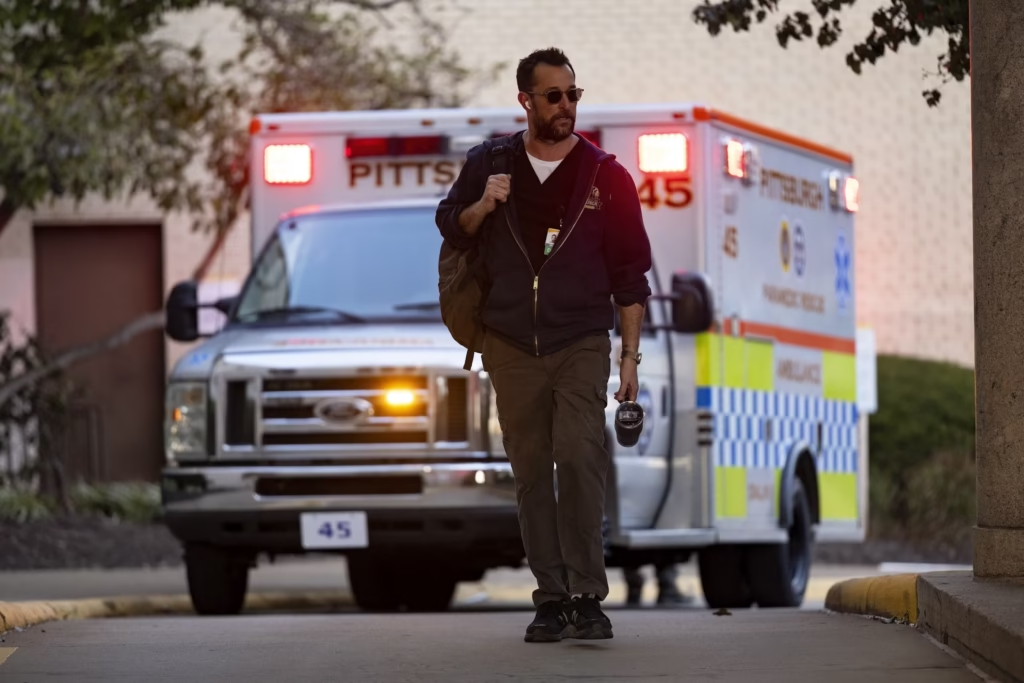Warning: Mild spoilers ahead!
As a healthcare worker, my perspective has often been that shows like E.R. or Greys Anatomy focus a little too much on the drama. As a result, I wasn’t super excited when I heard tell of a new medical drama known as The Pitt.
Even at the best of times, I’m rarely one to get caught up in the hype of a brand new TV show. When people go on and on about the next Game of Thrones or whatever, it mentally gets pushed further down my watchlist. I’m not sure why, it’s just something in how I’m wired. At least, it was. While I initially wrote The Pitt off before giving it a chance, I happened to catch part of an episode that a coworker was watching. I was immediately hooked. While I don’t know that I can contribute much to the overall discussion of this show, I wanted to try and share some thoughts here.

First things first – what is The Pitt?
I’d probably sum up The Pitt in a sentence by calling it a “medical drama meets 24“. Based in the fictional Pittsburgh Trauma Medical Hospital, it follows 15 near-realtime hours in a busy trauma centre.
Under the guidance of Attending Physician Dr. “Robby” Robinavitch, a team of healthcare professionals work to save lives. The team includes Doctors, Nurses, Interns and Students. The series is full of cascading and never-ending real-world issues: short staffing, budget constraints, healthcare worker assaults, long wait times and the ongoing mental health crisis. All play their part in creating the shift from hell.
What makes The Pitt different?
The Pitt did a great job of being engaging in ways that other dramas struggle with. While yes, there’s a degree of interpersonal conflict, it’s kept fairly low-key and plot specific. Instead, The Pitt leans in heavily on the medical side of things in a real and often gritty way. There are so many things that stood out to me on my watch-through but here’s just a few of my personal favourites:
Medical Accuracy at large
I’m not a doctor, so I’m not really in a position to claim that every single moment in this show was medically accurate. What I can say however is that I believe The Pitt is likely to be one of the most medically accurate dramas out there.
I work in prehospital emergency care. My field is less about finding firm diagnoses and often more about forming a clinical impression. You then treat what you find or reasonably presume might be happening. During my watch through I was often surprised at how real the presentation of patients, their complaints and symptoms felt.
The portrayal of medical conditions was so true-to-life that I almost found myself “playing along”. I was forming a clinical impression of patients based on what was being said on screen in real time. I’d find myself considering what I’d expect treatment options and (initial) interventions to be. Not only were the patients portrayed well, so were the medical staff as a whole. No extras running around shouting exciting sounding buzzwords (O2 stats anyone?). Instead, nurses call out pertinent information. Suggestions would be made by everyone and anyone while the medical team as whole were bedside. Treatment discussions would occur on the fly and the team would carry out common real-world interventions on their patients. It was refreshing to see!
Realistic portrayals of death and the dying
Another area that television shows often have a hard time portraying is the process of death. That final journey that we’ll ultimately all make is often over-dramatized. Patients clutch at their chests while screaming and thrashing around. Instead The Pitt does an outstanding job of keeping things real while navigating the more challenging aspects of the dying process.
I’ve always hated unrealistic portrayals of Cardiac Arrests (where someone’s heart has stopped). You’ll see patients get a couple of compressions, be defibrillated and then make a miraculous recovery. Unfortunately that just isn’t accurate. Effective CPR, BLS and ALS treatments will give a patient the absolute best odds at survival. However, the fact is that cardiac arrests aren’t pretty and often aren’t survivable.
Compressions, when done correctly, can be brutal. It’s not uncommon to feel ribs crack, or to have patients vomit during CPR. Resuscitation attempts are also often prolonged. They normally last at least 20 minutes outside of a hospital, and often longer inside of one. The Pitt does a great job of realistically portraying these moments without unrealistic miracle saves.
The show also does well at highlighting the more delicate and often difficult moments in the dying process. There’s a patient who is removed from life support, and another death that involves a significant conversation around respecting an advanced directive. Both are handled relatively delicately and accurately reflect the difficult conversations that are had every day. I hope in particular that the scenes surrounding advanced directives and DNRs might spur important conversations. Many people (myself included) can find themselves blindsided “in the moment” by decisions. It’s often helpful to have carefully discussed your loved ones (and your personal) wishes ahead of time.
Portrayal of Post Traumatic Stress Disorder
It’s well documented that PTSD is relatively common among health workers. I was somewhat surprised to see this highlighted across several episodes as we see the protagonist, Dr Robby, struggling with the effects of it. While it’s never explicitly called out by name – I personally was glad to see it was presented and never in a way that would suggest that he is “crazy”. instead, he’s shown as a good man who is struggling with a real mental health disorder.
Other real-world issues
Not only was the show medically accurate, it also heavily featured many real-world issues that are impacting the healthcare environment at large.
- Extended wait times
Several scenes in the show focus on the over-crowded and sometimes intense nature of the ER waiting room. While these scenes are exaggerated for dramatic effect, there’s no doubt that ER patients face increasingly long wait times. The reasons are far too many to get into here. They include limited access to Primary Care, a lack of hospital beds due to a lack of long-term care beds and short staffing. With that being said: You should absolutely go to your emergency room if you’re experiencing a medical emergency. It doesn’t matter what you think the wait time will be. - Holding the Wall
Hand in hand with extended wait times and mentioned briefly in one scene are Paramedics and EMTs “holding the wall”. This refers to a practice where lower-acuity patients are “offload delayed”. They are left on EMS stretchers in the care of EMS staff due to a lack of resources in an ER to take over patient care. This issue is far from isolated to the US. In the UK it was estimated EMS spent a total of 1.5 million hours on offload delay in 2024. - Short staffing
In one particularly heated scene, Dr Robby rants to management about the lack of nurses being employed by the hospital. Several countries are struggling with nurse recruitment and retention. There are several contributing factors to this and no real “golden bullet” solutions. - Healthcare worker assaults
Several scenes highlight verbal, and in one instance, physical abuse of healthcare workers. While it’s unfortunate and unacceptable, those who work on the front lines often face these challenges on a daily basis.
Would I recommend it?
Yes. I absolutely would.
While The Pitt might be a tough watch if you’re squeamish, it does a great job of walking the line between fiction and reality. The show is going to have viewers scrambling for the next episode. I personally believe that most viewers will also find it to be quite thought-provoking. Many scenes will stick with you long after the episode ends.
The show does a great job of highlighting difficult conversations that need to be had about healthcare and society at large. The question is, are we ready to have them?
If you enjoyed reading this post, please feel free to leave a comment below or Contact Me if you’ve got more to share!





